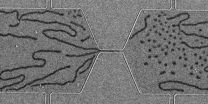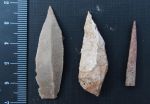(Press-News.org) Time may heal all wounds, but in the case of stroke survivors, the key to better recovery is to spend more time in an intensive physical therapy program, according to a University of Florida Health study.
After a stroke, the brain and body can start recovering immediately and can show improvement up to six months afterward, said UF Health researcher Janis Daly, Ph.D. But this study focused on people who had persistent disability even a year or more after completing standard care. The study found that extensive physical therapy helped them recover motor function, even though they began the study treatment a year or more after stroke.
'The recovery was meaningful to patients in terms of physical function. Each person's recovery was somewhat unique,' said Daly, the paper's lead author and a professor in the UF College of Medicine's department of neurology. 'Some had dramatic recovery, some had less. Some were able to perform functional tasks that they weren't able to do before; some recovered the ability to move their arm so they could actually place the arm for functional tasks, for example into the sleeve of a sweater.'
Daly said the average change in function for patients who had been severely affected by their stroke was clinically significant for arm movements and for performing complex tasks. For instance, a man who had been unable to lift a spoon to his mouth can now feed himself.
Inability to combine regular motions -- for example, flexing the shoulder and simultaneously extending the elbow while reaching for an object -- can be one result of a stroke. The patient may concentrate on the reaching movement of the arm, but the normal neural pathways are interrupted, and the patient's arm may flex inward toward the body instead of extending to reach for a glass of water or a fork, said Daly, also the director of the National Veterans Affairs Brain Rehabilitation Research Center of Excellence in Gainesville, Fla.
To help patients regain movements of the shoulders, arms and hands, which are crucial in many daily activities, researchers administered an intensive physical therapy program that included five hours of rehabilitation per day, five days per week, for 12 weeks to 39 study participants.
The researchers tested three different modes of rehabilitation. The first was motor learning rehabilitation. Daly compared motor learning rehabilitation after stroke to learning a new sport move, such as a beginner learning a tennis serve. In this type of rehabilitation, patients must concentrate on performing a movement as deliberately as possible, with as much normal movement as possible, and must practice the task repetitively.
'Think about a child learning to walk or to ride a bicycle,' Daly said. 'They must practice over and over until they come close to perfection.'
The second and third modes of rehabilitation were electrical stimulation rehabilitation and robotics-assisted rehabilitation. In electrical stimulation rehabilitation, electrodes comfortably stimulated the muscles on a person's forearm and caused the hand to lift. Participants in the robotics-assisted rehabilitation group practiced the reach movement using robot software. The software guided them to attempt to reach targets displayed on a computer monitor. Their forearm and hand were cradled in a support so participants could concentrate on moving the shoulder and elbow.
One group received five hours per day of motor learning alone, while the other two groups received motor learning for 3.5 hours and electrical stimulation or robotics-assisted rehabilitation for the remaining 1.5 hours per day. All three groups received some motor learning rehabilitation. Each of the groups improved significantly, on average doubling or nearly doubling their scores on a scale that assesses coordination.
Daly says the recovery for all three groups was equal, with no statistically significant difference between the groups. The researchers named a small sample size as a potential limitation of the study, pointing out that there might have been statistical differences in the results between groups if the group sizes had been larger. Because of the intensity of the program, one physical therapist worked with three patients; this ratio of therapist to patients was successful. Factoring in the salaries of the therapists and the cost of equipment used in rehabilitation, the researchers calculated that treatment for each patient cost between $4,500 and $5,600.
'Often after stroke, people can recover normal function without intensive treatment, in response to normal protective physiological processes. Some people recover quite well and can function normally. For this study, however, we enrolled people who had a stroke a year or more prior to their study participation, and who were still severely impaired,' Daly said. 'The magnitude of recovery we observed in our study is higher than any other studies that have been published so far, which supports the promise of longer treatment and more intensive treatment after stroke, even for those who are more severely impaired.'
INFORMATION:
Grants B2801R, B9024-S and B5080S from the Department of Veterans Affairs funded the study.
New ideas are bubbling up for more efficient computer memory.
Researchers at UCLA and the U.S. Department of Energy's Argonne National Laboratory announced today a new method for creating magnetic skyrmion bubbles at room temperature. The bubbles, a physics phenomenon thought to be an option for more energy-efficient and compact electronics, can be created with simple equipment and common materials.
Skyrmions, discovered just a few years ago, are tiny islands of magnetism that form in certain materials. If you wrapped one up into a sphere, its magnetic fields would ...
African-American adults -- particularly women -- are much more likely to know or be related to someone behind bars than whites, according to the first national estimates of Americans' ties to prisoners.
The research, led by Hedwig Lee, University of Washington associate professor of sociology, reveals the racial inequality wrought by the U.S. prison boom, with potentially harmful consequences to families and communities left lacking social supports for raising children and managing households.
In an article published May 20 in the Du Bois Review: Social Science Research ...
KNOXVILLE--The increasing use of video games is often blamed for children's lack of interest in physical activity, but a study by the University of Tennessee, Knoxville, recently published in the Games for Health Journal suggests that active video games may actually be a source of moderate or intense physical activity in children five to eight years old.
"Our study shows video games which wholly engage a child's body can be a source of physical activity," said Hollie Raynor, director of UT's Healthy Eating and Activity Laboratory and associate professor of nutrition. ...
(June 12, 2015) New research published in this month's edition of United European Gastroenterology journal suggests that supplementation with vitamin D may impact on the intestinal barrier dysfunction associated with Crohn's disease, and could have a role in the treatment of the condition. The study is by Professor Maria O'Sullivan and Tara Raftery. Department of Clinical Medicine, Trinity Centre for Health Sciences, St. James's Hospital, Dublin, Ireland.
Crohn's disease (CD) is a lifelong chronic relapsing and remitting gastrointestinal condition, characterised by inflammation, ...
Investigators at Disney Research Zurich have developed a method for achieving very accurate object segmentation of video by enabling human editors to work efficiently with state-of-the-art algorithms using a click-and-drag interface.
Segmentation, which identifies objects, backgrounds and other meaningful regions within an image or video, is a necessary step for many editing tasks and for image analysis. People can readily perceive objects and the composition of scenes despite variations in colors, lighting and contours, but despite significant advances in recent years, ...
When a new type of drug or therapy is discovered, double-blind randomized controlled trials (DBRCTs) are the gold standard for evaluating them. These trials, which have been used for years, were designed to determine the true efficacy of a treatment free from patient or doctor bias, but they do not factor in the effects that patient behaviors, such as diet and lifestyle choices, can have on the tested treatment.
A recent meta-analysis of six such clinical trials, led by Caltech's Erik Snowberg, professor of economics and political science, and his colleagues Sylvain Chassang ...
Thousands of stone tools from the early Upper Paleolithic, unearthed from a cave in Jordan, reveal clues about how humans may have started organizing into more complex social groups by planning tasks and specializing in different technical skills.
The Journal of Human Evolution published a study of the artifacts from Mughr el-Hamamah, or Cave of the Doves, led by Emory University anthropologists Liv Nilsson Stutz and Aaron Jonas Stutz.
"We have achieved remarkably accurate estimates of 40,000 to 45,000 years ago for the earliest Upper Paleolithic stone tools in the ...
(Boston)--Men with benign prostate enlargement who used finasteride (also known as proscar and propecia) to treat their condition, experienced worsening erectile dysfunction (ED) that did not resolve with continued treatment. In addition, they experienced a reduction in their testosterone levels leading to hypogonadism (little to no production of sex hormones). However, men who used tamsulosin (flomax) experienced none of these adverse side effects.
The findings, currently available online in the journal Hormone Molecular Biology and Clinical Investigation, were led by ...
Animals wearing new tagging and tracking devices give a real-time look at their behavior and at the environmental health of the planet, say research associates at the Smithsonian Tropical Research Institute in the June 12 issue of Science magazine.
"We suggest that a golden age of animal tracking science has begun," they predict. "The upcoming years will be a time of unprecedented, exciting discoveries."
Driven, in part, by consumer demand in the past five years, radio-tracking technology has been replaced by smaller GPS tags that allow scientists to accurately track ...
PROVIDENCE, R.I. - In a recent study, nearly half of all veterans who died from drug overdoses while prescribed opioids for pain were also receiving benzodiazepines, or benzos, which are common medications for the treatment of anxiety, insomnia and alcohol withdrawal. Veterans prescribed higher doses of benzodiazepines while concurrently receiving opioids were at greater risk of overdose death than those on lower doses of benzodiazepines. The results of the study by researchers from Rhode Island Hospital, Boston Medical Center, and the Veteran Affairs Ann Arbor Healthcare ...

